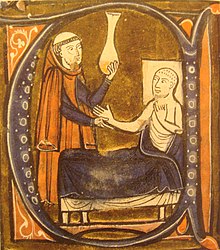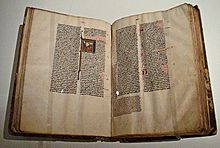Gerard of Cremona
 From Wikipedia the free encyclopedia
From Wikipedia the free encyclopedia

Gerard of Cremona (Latin: Gerardus Cremonensis; c. 1114 – 1187) was an Italian translator of scientific books from Arabic into Latin. He worked in Toledo, Kingdom of Castile and obtained the Arabic books in the libraries at Toledo. Some of the books had been originally written in Greek and, although well known in Byzantine Constantinople and Greece at the time, were unavailable in Greek or Latin in Western Europe. Gerard of Cremona is the most important translator among the Toledo School of Translators who invigorated Western medieval Europe in the twelfth century by transmitting the Arabs' and ancient Greeks' knowledge in astronomy, medicine and other sciences, by making the knowledge available in Latin. One of Gerard's most famous translations is of Ptolemy's Almagest from Arabic texts found in Toledo.[2]
Confusingly, there appear to have been two translators of Arabic text into Latin known as Gerard of Cremona. The first was active in the 12th century and concentrated on astronomy and other scientific works, while the second was active in the 13th century and concentrated on medical works.
Life
[edit]Gerard was born in Cremona in northern Italy. Dissatisfied with the philosophies of his Italian teachers, Gerard went to Toledo. There he learned Arabic, initially so that he could read Ptolemy's Almagest,[3] which had a traditionally high reputation among scholars, but which, before his departure to Castile, was not yet known in Latin translation. The first Latin translation was made, from the Greek around 1160 in Sicily.[4] Although we do not have detailed information of the date when Gerard went to Castile, it was no later than 1144.
Toledo, which had been a provincial capital in the Caliphate of Cordoba and remained a seat of learning, was safely available to a Catholic like Gerard, since it had been conquered from the Moors by Alfonso VI of Castile in 1085. Toledo remained a multicultural capital, insofar as its rulers protected the large Jewish and Muslim quarters, and kept their trophy city an important centre of Arab and Hebrew culture. One of the great scholars associated with Toledo was Rabbi Abraham ibn Ezra, Gerard's contemporary. Mozarabic culture was common in the area. The city was full of libraries and manuscripts, and was one of the few places in medieval Europe where a Christian could be exposed to Arabic language and culture.
In Toledo Gerard devoted the remainder of his life to making Latin translations from the Arabic scientific literature.
Gerard's translations
[edit]
Gerard of Cremona's Latin translation of the Arabic version of Ptolemy's Almagest made c. 1175 was the most widely known in Western Europe before the Renaissance. Unbeknownst to Gerard, an earlier translation of the Almagest had already been made in Sicily from the original Greek c. 1160 under the aegis of Henricus Aristippus, although this version was not as widely used in the Middle Ages as Gerard's version.[5] George of Trebizond and then Johannes Regiomontanus retranslated it from the Greek original in the fifteenth century. The Almagest formed the basis for Western astronomy until it was eclipsed by the theories of Copernicus.
Gerard edited for Latin readers the Tables of Toledo, the most accurate compilation of astronomical data ever seen in Europe at the time.[citation needed] The Tables were partly the work of Al-Zarqali, known to the West as Arzachel, a mathematician and astronomer who flourished in Cordoba in the eleventh century.
Al-Farabi, the Islamic "second teacher" after Aristotle, wrote hundreds of treatises. His book on the sciences, Kitab lhsa al Ulum, discussed classification and fundamental principles of science in a unique and useful manner. Gerard rendered it as De scientiis (On the Sciences).
Gerard translated Euclid’s Geometry and Alfraganus's Elements of Astronomy.[6]
Gerard also composed original treatises on algebra, arithmetic and astrology. In the astrology text, longitudes are reckoned both from Cremona and Toledo.
In total, Gerard of Cremona[7] translated 87 books from the Arabic language,[8] including such originally Greek works as Ptolemy's Almagest, Archimedes' On the Measurement of the Circle, Aristotle's On the Heavens, and Euclid's Elements of Geometry; and such originally Arabic works as al-Khwarizmi's On Algebra and Almucabala, Jabir ibn Aflah's Elementa astronomica,[9] and works by al-Razi (Rhazes).[10] Gerard of Cremona was also creator of anatomical terms.[11] The Latin translation of the Calendar of Córdoba, entitled Liber Anoe, has also been attributed to Gerard.[12]
A second Gerard Cremonensis
[edit]
Some of the works credited to Gerard of Cremona are probably the work of a later Gerard Cremonensis, working in the thirteenth century, who was also known as Gerard de Sabloneta (Sabbioneta).[13] The later Gerard focused on translating medical texts rather than astronomical texts,[13] but the two translators have understandably been confused with one another. His translations from works of Avicenna are said to have been made by order of the emperor Frederick II.
Other treatises attributed to the "Second Gerard" include the Theoria or Theorica planetarum,[14] and versions of Avicenna’s Canon of Medicine— the basis of the numerous subsequent Latin editions of that well-known work — and of the Almansor of al-Razi ("Rhazes" in Latin-speaking Europe). The attribution of the Theorica to Gerard of Sabbioneta is not well supported by manuscript evidence and should not be regarded as certain.
See also
[edit]Notes
[edit]- ^ Inventions et decouvertes au Moyen-Age, Samuel Sadaune, p. 44.
- ^ Kunitzsch, Paul (May 1986). "The Star Catalogue Commonly Appended to the Alfonsine Tables". Journal for the History of Astronomy. 17 (2): 89. doi:10.1177/002182868601700202. ISSN 0021-8286. Retrieved 11 April 2022.
Gerard of Cremona's Latin translation made in Toledo about 1175 from the Arabic
- ^ Grant, Edward, ed. (1974), "The Translation of Greek and Arabic Science into Latin", A Source Book in Medieval Science, Cambridge: Harvard University Press, p. 35, ISBN 9780674823600,
For love of the Almagest, which he could not find at all among the Latins, he went to Toledo; there seeing the abundance of books in Arabic on every subject … he learned the Arabic language in order to translate.
- ^ R. W. Southern, The Making of the Middle Ages New Haven: Yale University Press, 1953, p. 64-65.
- ^ R. W. Southern, The Making of the Middle Ages, New Haven: Yale University Press, 1953, p. 64-65; L. D. Reynolds and Nigel G. Wilson, Scribes and scholars: A guide to the transmission of Greek and Latin literatureOxford: Clarendon Press, 1974, p. 106.
- ^ For a list of Gerard of Cremona's translations see: Edward Grant (1974) A Source Book in Medieval Science, (Cambridge: Harvard Univ. Pr.), pp. 35-8 or Charles Burnett, "The Coherence of the Arabic-Latin Translation Program in Toledo in the Twelfth Century," Science in Context, 14 (2001): at 249-288, at pp. 275-281.
- ^ C. H. Haskins, Renaissance of the Twelfth Century, p. 287, "more of Arabic science passed into Western Europe at the hands of Gerard of Cremona than in any other way."
- ^ Edward Grant A Source Book in Medieval Science, (Cambridge: Harvard Univ Press, 1974), pp. 35-38.
- ^ V. J. Katz, A History of Mathematics: An Introduction, p. 291.
- ^ Jerome B. Bieber. Medieval Translation Table 2: Arabic Sources Archived 2001-03-18 at the Wayback Machine, Santa Fe Community College.
- ^ Arráez-Aybar, Luis-A (2015). "Toledo School of Translators and their influence on anatomical terminology". Annals of Anatomy - Anatomischer Anzeiger. 198: 21–33. doi:10.1016/j.aanat.2014.12.003. PMID 25667112.
- ^ Miquel Forcada, 'Calendar of Córdoba', in Encyclopaedia of Islam, 3rd edn, ed. by Kate Fleet and others (Leiden: Brill, 2007-), doi:10.1163/1573-3912_ei3_COM_24375.
- ^ a b Ostler, Nicholas (2009). Ad Infinitum. Harper Press. p. 211. ISBN 978-0007343065.
- ^ Pedersen, Olaf. The origins of "Theorica Planetarum". Journal for History of Astronomy. Vol. 12 (1981), pp 113-123.
References
[edit]- Burnett, Charles (2001). "The Coherence of the Arabic-Latin Translation Program in Toledo in the Twelfth Century". Science in Context. 14 (1–2): 249–288. doi:10.1017/s0269889701000096. S2CID 143006568.
- Campbell, Donald (2001). Arabian Medicine and Its Influence on the Middle Ages. Routledge. (Reprint of the London, 1926 edition). ISBN 0-415-23188-4.
- Haskins, Charles Homer. The Renaissance of the Twelfth Century. Cambridge: Harvard Univ. Pr., 1927. See especially chapter 9, "The Translators from Greek and Arabic".
- Katz, Victor J. (1998). A History of Mathematics: An Introduction. Addison Wesley. ISBN 0-321-01618-1.
External links
[edit]- O'Connor, John J.; Robertson, Edmund F., "Gerard of Cremona", MacTutor History of Mathematics Archive, University of St Andrews
- Beazley, Charles Raymond (1911). . Encyclopædia Britannica. Vol. 11 (11th ed.). p. 764.
 This article incorporates text from a publication now in the public domain: Herbermann, Charles, ed. (1913). "Gerard of Cremona". Catholic Encyclopedia. New York: Robert Appleton Company.
This article incorporates text from a publication now in the public domain: Herbermann, Charles, ed. (1913). "Gerard of Cremona". Catholic Encyclopedia. New York: Robert Appleton Company.